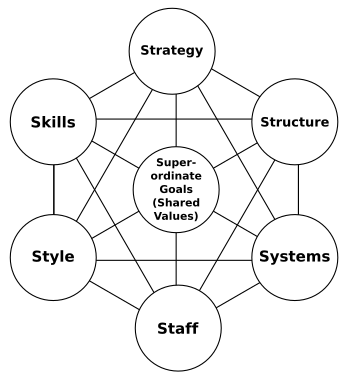McKinsey 7S Framework: Difference between revisions
m r2.6.4) (Robot: Adding de:7-S-Modell |
No edit summary |
||
| Line 1: | Line 1: | ||
[[Image:McKinsey_7S_framework.svg|thumb|350px|Visual representation of the model]] |
[[Image:McKinsey_7S_framework.svg|thumb|350px|Visual representation of the model]] |
||
The '''McKinsey 7S Framework''' is a [[management]] model<ref> |
|||
| ⚫ | |||
{{cite book |
|||
| last = Spencer |
|||
| first = Tom |
|||
| authorlink = Tom Spencer |
|||
| coauthors = |
|||
| title = McKinsey 7 S framework |
|||
| publisher = Tom Spencer |
|||
| year = 2011 |
|||
| location = Sydney |
|||
| pages = |
|||
| url = http://www.tomspencer.com.au/2008/09/13/mckinsey-7-s-model-analysis-framework/ |
|||
| doi = |
|||
| id = |
|||
| ⚫ | | isbn = }}</ref> developed by well-known business consultants [[Robert H. Waterman, Jr.]] and [[Tom Peters]] (who also developed the MBWA-- "[[Management By Walking Around]]" motif, and authored [[In Search Of Excellence|''In Search of Excellence'']]) in the 1980s. This was a strategic vision for groups, to include [[business]]es, [[business unit]]s, and teams. The 7S are structure, strategy, systems, skills, style, staff and shared values. |
||
The model is most often used as a tool to assess and monitor changes in the internal situation of an organization. |
The model is most often used as a tool to assess and monitor changes in the internal situation of an organization. |
||
Revision as of 04:48, 2 December 2011

The McKinsey 7S Framework is a management model[1] developed by well-known business consultants Robert H. Waterman, Jr. and Tom Peters (who also developed the MBWA-- "Management By Walking Around" motif, and authored In Search of Excellence) in the 1980s. This was a strategic vision for groups, to include businesses, business units, and teams. The 7S are structure, strategy, systems, skills, style, staff and shared values.
The model is most often used as a tool to assess and monitor changes in the internal situation of an organization.
The model is based on the theory that, for an organization to perform well, these seven elements need to be aligned and mutually reinforcing. So, the model can be used to help identify what needs to be realigned to improve performance, or to maintain alignment (and performance) during other types of change.
Whatever the type of change – restructuring, new processes, organizational merger, new systems, change of leadership, and so on – the model can be used to understand how the organizational elements are interrelated, and so ensure that the wider impact of changes made in one area is taken into consideration.
When it comes to asking the right questions, we've developed a Mind Tools checklist and a matrix to keep track of how the seven elements align with each other. Supplement these with your own questions, based on your organization's specific circumstances and accumulated wisdom.
OBJECTIVE OF THE MODEL
To analyze how well an organization is positioned to achieve its intended objective
Usage
Improve the performance of a company Examine the likely effects of future changes within a company Align departments and processes during a merger or acquisition Determine how best to implement a proposed strategy
The Seven Interdependent Elements The basic premise of the model is that there are seven internal aspects of an organization that need to be aligned if it is to be successful
Hard Elements Strategy Structure Systems
Soft Elements Shared Values Skills Style Staff
External Links
- A Brief History of the 7-S ("McKinsey 7-S") Model - Tom Peters' blog post describing the origins of the model.
- Structure is Not Organization -Business Horizons, June 1980.
- ^
Spencer, Tom (2011). McKinsey 7 S framework. Sydney: Tom Spencer.
{{cite book}}: Cite has empty unknown parameter:|coauthors=(help)
